
To most Pickles refer to the art of preserving food. And to others it is a tiny pinch of accompaniment with another more important and popular food item. But to me, a Pickle is like Abstract Art. I don’t understand it completely, yet at the same time it tickles my senses with it’s vibrant colours, the strong aroma of the mixtures inside the pickle bottle and finally the strong taste. I am not a pickle person. But I’ll pursue pickles with my camera and research as they always catch my fancy. There is nothing in a pickled bottle that will not catch my fancy – top it up with the hard work and the effort and the mathematical precisions in the proportions that go into pickle-making and Pickles turn gourmet – a delicacy and an art!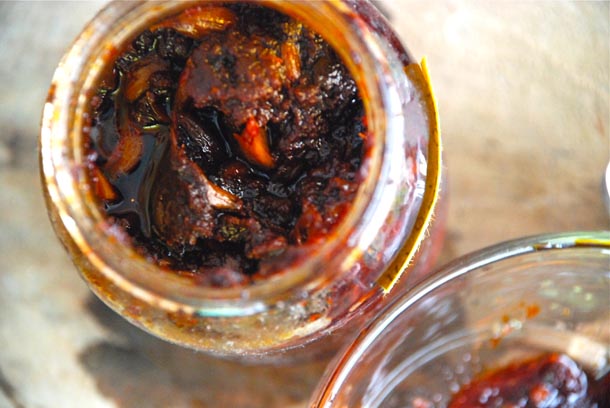
I have never been so mersmerised with Pickles as I have been this time. My annual summer holidays in Kolkata is just the right mini hibernation that I need to get away from my usual life in Dubai. I have been immersing myself in searching for food subjects for my post. And I have been focusing on subjects that I wouldn’t be able to replicate by myself at other times. This time my sole focus has been Kolkata’s street food, specially Chinese food – from street food to fine-dining. The second focus has been my Mum-in-law’s traditional cooking. She has many hand-written notebooks where she writes down all the recipes that she collects. And one such notebook is her ‘Diary of Pickles’. I call this diary the Mother of all Pickles, or rather Mother (in-law) of all pickles!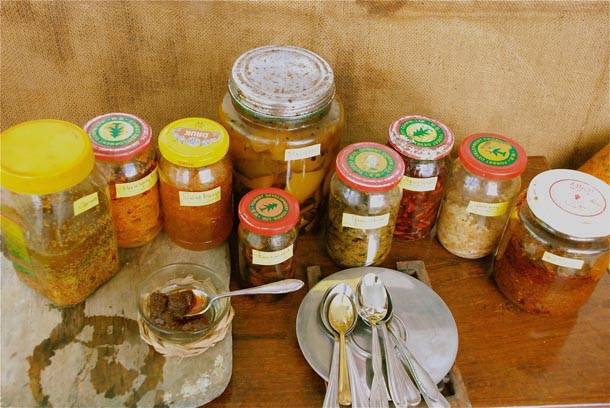
Ma, as I lovingly call her, is fascinated by recipes. She collects recipes – from magazines, newspapers, from television. She doesn’t like cutouts or clippings, she loves organising and segregating them into different notebooks – writing them down as she collects them. At the point of writing this post, Ma‘s shelf had 15 bottles of Pickles – fat bottles, thin bottles, small bottles, large bottles, square bottles, round bottles, plastic containers, glass containers, tin containers – all containing Pickles. Sweet Pickles, sour Pickles, spicy Pickles – pickles of all kinds!
I want my photographs of Ma’s pickles to be the best that I have ever taken in my life (so far!). And share the story of her pickles with all my readers , far and wide. That’s the only way I can do justice to the tremendous effort she has taken to make all these different kind of pickles. For her, its labour of love. ‘Toder jonyo!/All for you guys!’ she always says. Yes Ma, we know that. But do you really think that we can have so many of them in such a short time?
Carrots, Mangoes, Gooseberry, Garlic, Capsicum, Olives, Limes etc – if that sounds like a grocery list, well you are wrong. That’s just a few of the fruits and the vegetables that have been pickled by Ma. Next successive posts will have pickle recipes and if you happen to meet me during these days I’ll most probably be blurting out ‘I have been pickled!’
Pickle Nostalgia
Memories of Pickles occupy an important place in my childhood. I don’t have any recollection of my Mum making any pickle. But I do remember my grandmums (both maternal and paternal) preparing pickles. Chopped up ingredients would be laid out on the terraces or balconies for drying up and it was all the childrens’ duty in the house to run up and bring them down every-time the skies would swollen up with thick monsoon clouds. Sneaking into the terrace and taking a few pieces of spiced up dried mangoes (before the few lucky ones manage to go into the bottles) would also be a favourite pass-time!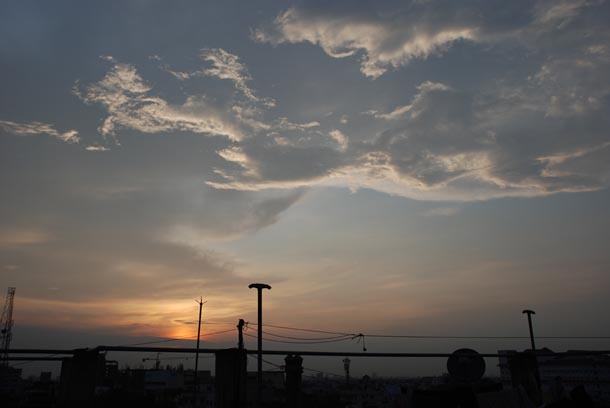
Pickles is to Indian Culture is what Cheese is to French Culture (read here). While from tomorrow I’ll be posting a pickle recipe a day till my Mum-in-law’s pickle jars are exhausted, for today you may go into a photographic journey into the world of pickles in my Photo-gallery. Do enjoy a mini photo-journey into Pickles below. These are from my personal album, so I would request you not to use them. You may also scroll down to read more about Pickles – its’ history and geographical variations, however gathered from the internet.
In the mean-while keep smiling and say ‘Pickle’ whenever you are being clicked. It will bring the best smile in you – that is why perhaps everything is served with a Pickle in a restaurant. Think about it. While I think on my. my next post… which is on Hot Garlic Pickle!
Unblogging it all… Ishita


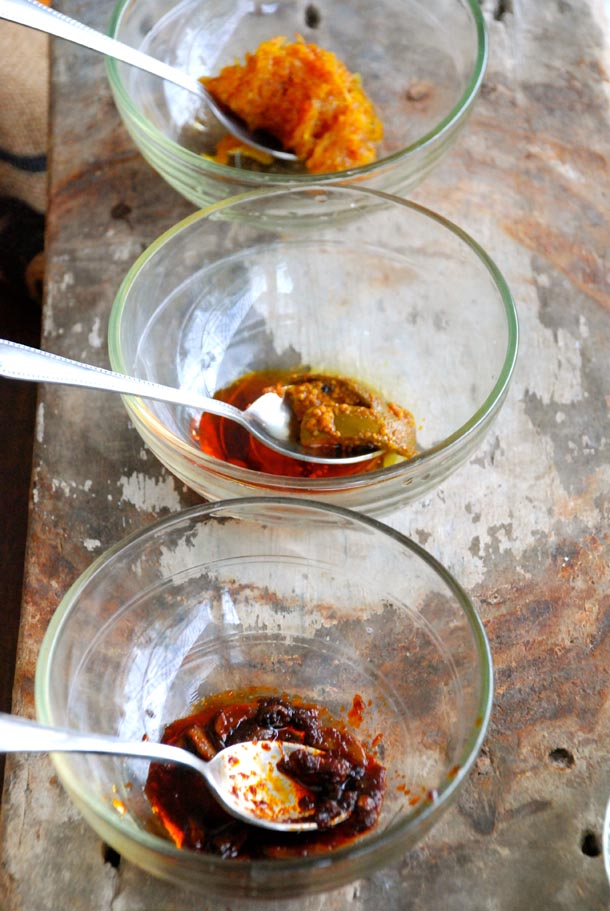
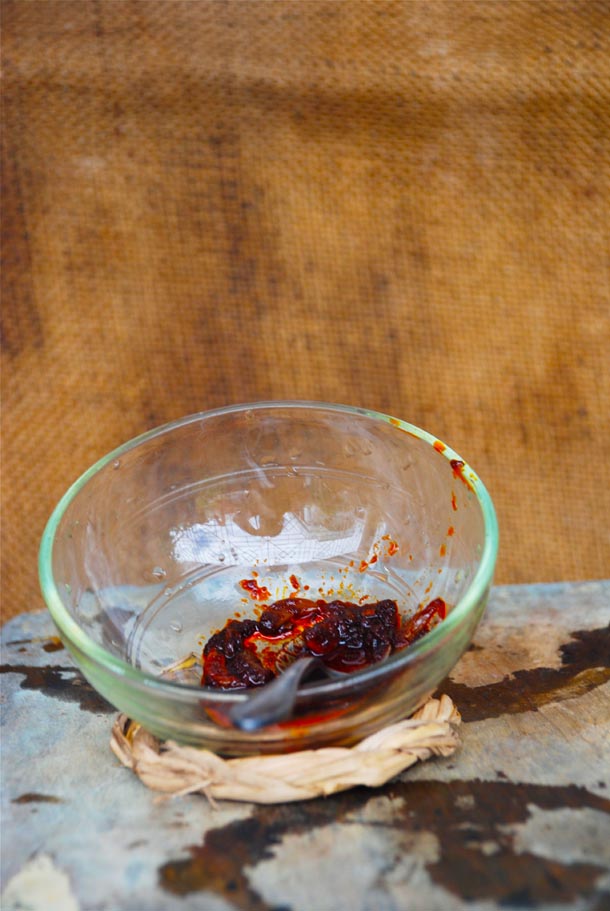
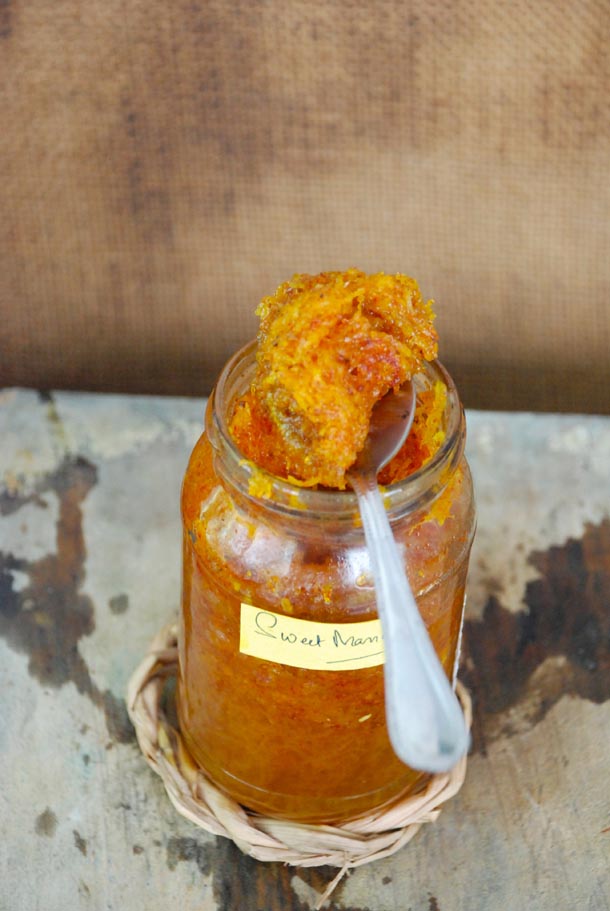
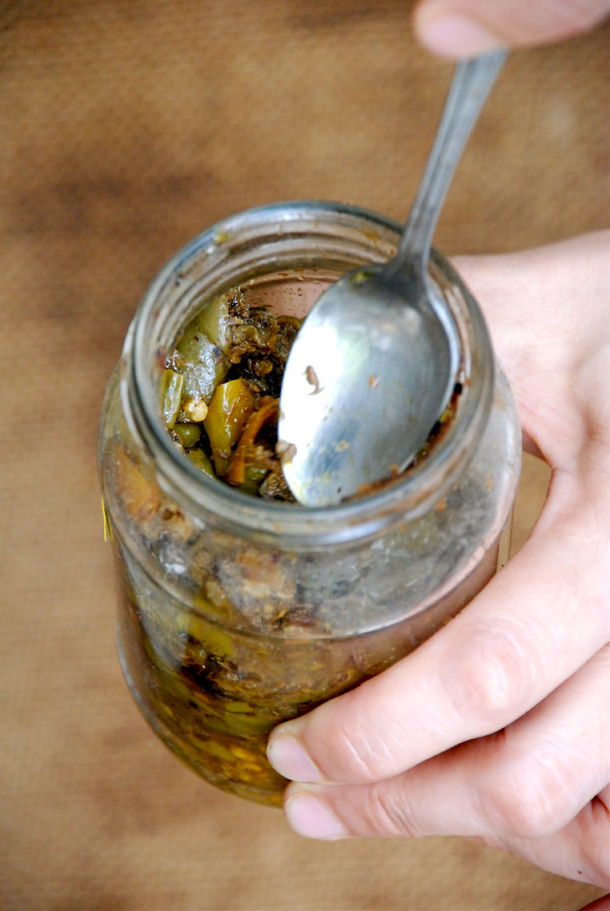
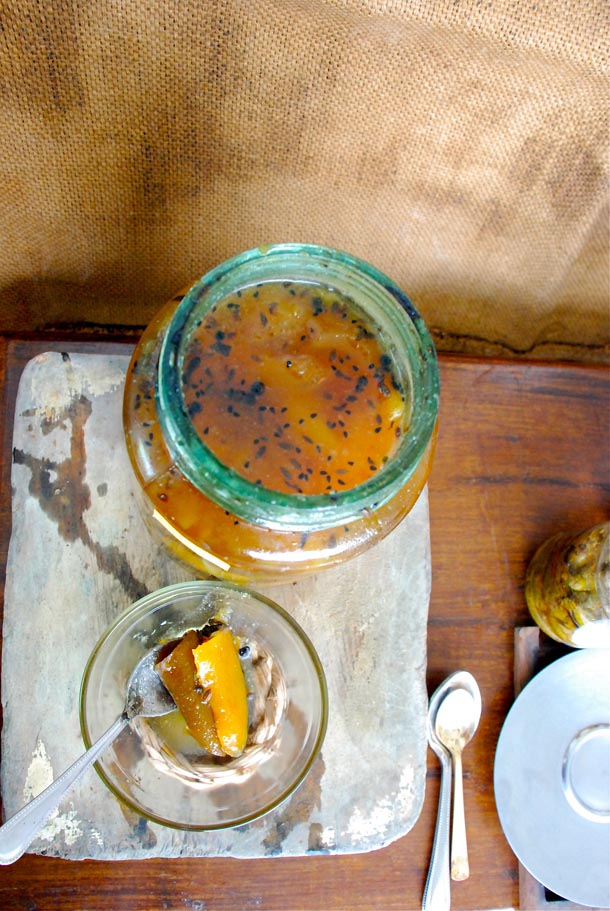
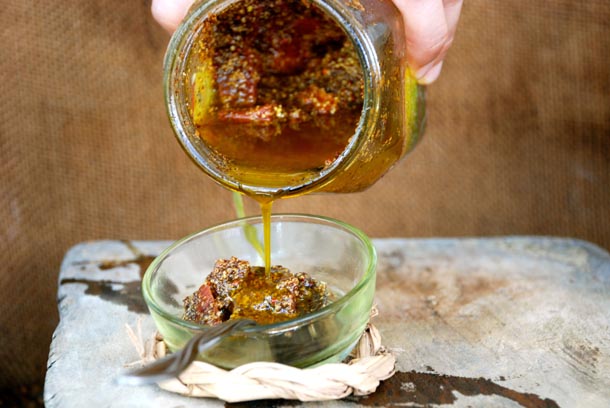
History of Pickles
Pickles seem to date back to as early as 2,000 BC. Pickles have been a part of regional culinary history all across cultures, though there is a difference in the way Pickles are made in different countries. Cucumber Pickles are the earliest examples of Pickles and can be traced back to Mesopotamia. From Cucumbers originating from India and which were brought to Mesopotamia by the inhabitants.
Pickles have also been mentioned in the Bible while the a few secrets to Cleopatra’s beauty are also attributed to the effectiveness of pickles! Apart from Cleopatra, other notable pickle-lovers were Emperors Julius Caesar and Tiberius, King John and Queen Elizabeth I of England, Amerigo Vespucci (after whom America has been named) George Washington, Thomas Jefferson and Napoleon Bonaparte. In-fact, Amerigo Vespucci was a pickle merchant before he became an explorer!
The English word ‘pickle’ derives from the Middle English pikel, first recorded around 1400 and means ‘a spicy sauce or gravy served with meat or fowl’. Some believe it is derived from the Dutch word pekel, which also means brine.
The Jewish too loved pickles. A wide variety of Pickles were produced in ancient Egypt and Mesopotamia. Until recently, sauerkraut (pickled fermented cabbage) was a mainstay throughout Central and Eastern Europe. Over the centuries, Ashkenazi Jews filled wooden barrels or ceramic crocks with cabbage, cucumbers or beets, leaving them in root cellars to ferment in salt brine seasoned with spices. (Info Courtesy: Pickle Guys)
The process of Pickling
Pickling is an art, a time-consuming art. In less romantic words it is the process of preserving food by anaerobic fermentation in brine (a solution of salt in water) to produce lactic acid, or marinating and storing it in an acid solution, usually vinegar (acetic acid). The resulting food is called a pickle. This procedure gives the food a salty or sour taste.
Pickling can preserve perishable foods for months. In-fact, the process was invented to preserve food. Cultural differences give rise to different pickling techniques. Once a pickle has been made, it’s storage is equally important. It has to be kept in air-tight containers and moisture shouldn’t creep in.
Though Pickles do form an integral part of Bengali kitchens, they are definitely not taken with every meal as is done in many parts of North India or South India.

Pickling around the world… Asia, Middle-East, Europe (Info Courtesy: Wikipedia)
In India, Pickles form an important part of regional cuisine and the hierarchy of importance also differs from one state to other. Pickles in India are known by different names – Achar in Punjabi and Hindi, Uppinakaayi in Kannada, Lonacha in Marathi, Oorukai in Tamil, Ooragaya in Telugu. Pickles are made from mango, lime, amla/Indian gooseberry, chilli, vegetables such as egg plants, carrots, cauliflower,tomato, bitter gourd, green tamarind, ginger, garlic, onion, citron etc. These fruits/vegetables are mixed with other ingredients – salt, spices, vegetable oils and is set to mature. A special variety of mango pickle prepared in India’s Andhra Pradesh State called Avakkaya is very popular. This pickle, often described as king of all pickles, is a fine blend of cut mango pieces, red chilli powder, mustard seed powder, salt and sesame oil each ingredient used in specified proportion all raw and allowed to mature for few weeks in porcelain containers in hot summer.
In Sri Lanka, achcharu is traditionally prepared out of carrots, onions, and ground dates. Mixed with mustard powder, ground pepper, crushed ginger, garlic and vinegar, these items are seasoned in a clay pot.
In Pakistan, Pickles are known locally as Achaar (in Urdu) and come in a variety of flavours. Amongst some of the most popular is the traditional mixed Hyderabadi pickle, a common delicacy and staple prepared from an assortment of fruits (most notably mangoes) and vegetables blended with selected spices.
East Asia
Indonesian pickles, açar, are typically made out of cucumber, carrot, bird’s eye chilies, and shallots, these items being seasoned with vinegar, sugar and salt. Fruits, such as papaya and pineapple are also sometimes pickled. In the Philippines, achara is primarily made out of green papaya, carrots, and shallots, with cloves of garlic and vinegar. In Vietnam, vegetable pickles are called dưa muối (salted vegetables) or dưa chua (sour vegetables). China is home to a huge variety of pickled vegetables, including radish, baicai (Chinese cabbage, notably suan cai, la bai cai, pao cai, and Tianjin preserved vegetable), zha cai, chili pepper and cucumber, among many others. Japanese tsukemono (pickled foods) include takuan (daikon), umeboshi (ume plum), gari & beni shoga (ginger), turnip, cucumber, and Chinese cabbage. In Korea, Pickles are called Kimchi and is a very common side dish. Kimchi is usually made from pickled cabbage and radish, but is also made from green onions, garlic stems, chives and a host of other vegetables. Kimchi is popular throughout East Asia. Jangajji is another example of pickled vegetables.
Middle East
In Iran, Pickles are called Torshi in Persian are commonly made from turnips, peppers, carrots, green olives, cucumbers, cabbage, lemons, and cauliflower. In Arab countries, pickles (called mekhallel in Arabic) are commonly made from turnips, peppers, carrots, green olives, cucumbers, beetroot, cabbage, lemons, and cauliflower.
Turkish pickles, called turşu, are made out of vegetables, roots, and fruits such as peppers, cucumber, Armenian cucumber, cabbage, tomato, eggplant (aubergine), carrot, turnip, beetroot, green almond, baby watermelon, baby cantaloupe, garlic, cauliflower, bean and green plum. A mixture of spices flavor the pickles.
Europe… East, West, North & South
Romanian Pickles are made out of beetroot, cucumbers, green tomatoes (gogonele), carrots, cabbage, bell peppers, melons, mushrooms, turnips, celery and cauliflower. Meat, like pork, can also be preserved in salt and lard. In Albania, Bulgaria, Serbia, and Macedonia, mixed pickles known as turshi, form popular appetizers, which are typically eaten with rakia. Pickled green tomatoes, cucumbers, carrots, bell peppers, peppers, eggplants, and sauerkraut are also popular. Polish traditional pickles are cucumbers and cabbage, but other pickled fruits and vegetables, including plums, pumpkins and mushrooms are also common. Russian pickled items include beets, mushrooms, tomatoes, cabbage, cucumbers, ramsons, garlic, eggplant (which is typically stuffed with julienned carrots), custard squash, and watermelon. In Ukraine, garden produce is commonly pickled using salt, dill, currant leaves and garlic and is stored in a cool, dark place.
In Britain, pickled onions and pickled eggs are often sold in pubs and fish and chip shops. Pickled beetroot, walnuts, and gherkins, and condiments such as Pickle and piccalilli are typically eaten as an accompaniment to pork pies and cold meats, sandwiches or a ploughman’s lunch. Other popular pickles in the UK are pickled mussels, cockles, red cabbage, mango chutney, sauerkraut, and olives. An Italian pickled vegetable dish is Giardiniera, which includes onions, carrots, celery and cauliflower. Many places in southern Italy, particularly in Sicily, pickle eggplants and hot peppers. Pickled herring, rollmops, and salmon are popular in Scandinavia. Pickled cucumbers and red garden beets are important as condiments for several traditional dishes. Pickled capers are also common in Scandinavian cuisine.
Coriander seeds are one of the spices popularly added to pickled vegetables in Europe.
Americas
In the United States and Canada, pickled cucumbers, often referred to simply as ‘pickles’, olives, and sauerkraut are most popular, although pickles popular in other nations (such as the pickled tomatoes commonly offered in New York City delicatessens) are also available. Giardiniera, a mixture of pickled peppers, celery and olives, is a popular condiment in Chicago and other cities with large Italian-American populations, and is often consumed with Italian beef sandwiches. Pickled eggs are common in the Upper Peninsula of Michigan. Pickled herring is available in the Upper Midwest. Pennsylvania Dutch Country has a strong tradition of pickled foods, including chow-chow and red beet eggs. In the Southern United States, pickled okra and watermelon rind are popular, as are deep-fried pickles and pickled pig’s feet, chicken eggs, quail eggs and pickled sausage. In Mexico, chile peppers, particularly of the Jalapeño and serrano varieties, pickled with onions, carrots and herbs form common condiments.
In-fact, more than half the cucumbers grown in the U.S. are made into pickles!
Info Source: Indian Pickle @Wikipedia, Pickles @Wikipedia


🙂 It is 7:40 AM and I am hungry for ‘preserves’ – how can that be?
LikeLike
Possible, absolutely possible… after all Pickles are meant to tickle our senses – all of them and that can be done at any time of the day… I’m sure you’ll have a great day as your senses are already awake… Let me know how your day went!
LikeLike
Yes and my mouth is watering. My dentist told me that it is a fact that when a mouth waters it indicates hunger. Thanks for tickling my senses !! haha
LikeLike
Ishita!!!! don’t do this to me babe 😉
LikeLike
What am I doing Neelu? More to come:)
LikeLike
So delicious and mouthwatering pickles!!!need the recipes dear..clicks are so awesome and so tempting
LikeLike
Thank you so much… yes, the next few posts will be with the recipes:)
LikeLike
Pingback: Hot Garlic Pickle… The Pickled Diary – Episode 1 «
that is a huge coof pickles.. interesting that ur ma writes down all recipes.. my amma has a huge file of cutouts!!!
where as i write it down and also have cut outs and now a blog!!!
LikeLike
Actually I keep on telling her that she should have started typing them down – then we could have easily started a blog… she has so so so many of them. For me, I have millions of links ‘bookmaked’!
LikeLike
“Pickes is to Indian cuisine what Cheese is to French!” So well said and can only come from you. Apologies for not being able to keep pace with your writing but its wonderful and refreshing to read everytime I come back to your blog. Keep it going!
LikeLike
Sorry to burst the bubble but I came across that line from TOI article which I have already mentioned. Please don’t apologise – you have been one of the few friends who have been encouraging me from the beginning – and I tell everyone that:)
LikeLike
I remember my grandmothers making pickles in our ancestral homes! And they made it in BULK!! Too lazy myself and health conscious with R’s hypertension. Wish I was closer to you, would have wangled a couple of bottles 🙂
LikeLike
Madhu, even I’m not really a pickle person. But I find them fascinating – the colours, the intense taste etc… high Sodium content in pickles would be bad for R… I wish I could send a few of them to you. Actually, I wish I could take a few back with me to Dubai!
LikeLike
It’s funny we have taken the word pickle to really mean a cured cucumber. This was an informative reminder of what “pickle” actually means. Worldwide it’s the process. I like our American pickles on a burger but what you’ve got going on with ‘Ma’ is a world unto itself. And those photos are stunning. I could eat these everyday with everything… (well I guess i’m not the only one).
Again… great post.
LikeLike
Thank you Wendy! Actually, it’s because of Ma’s huge pickled project that I got hooked onto the subject. It’s an amazing art for sure – pickle-making!
LikeLike
hey, my mouth is watering…yum yum….
LikeLike
Very nice photos Ishita, and a very interesting read. Thoroughly enjoyed it! What I would do to go visit your mother in law and get as near as possible to her handwritten cookbooks lol Won’t do no harm, will only study for a few month looool :))
LikeLike
Pingback: Authentic Bengali Cuisine… In ‘Slight’ Details «
Pingback: Rasgulla Macapuno On TV & Shubho Bijoya to all! «
Pingback: Living By The Water With Sunset As Prop – Kolkata & the Ganges «
Pingback: Semaiya Kheer/Vermicelli Pudding, Eid in Dubai… Eid Mubarak! «
Pingback: Gajorer Payesh/Carrot Pudding… Wishing Everyone A Happy Diwali! «
Pingback: Notun Gurer Payesh/Traditional Bengali Rice Pudding & My Dida «
Pingback: Shondesh/Sandesh Pudding… Guest Post For Sudeshna From Cook Like A Bong! «
are there any non-veg pickles ??
LikeLike
Oh yes! You do have non-veg pickles as well. Mutton pickle or fish pickle is very very popular. Even dried shrimp pickle. ‘Kodi Avakaya’ is a very popular Andhra Chicken pickle.
LikeLike
where can i find some recipes 🙂
LikeLike
Here’s one on Chicken pickle – http://www.sailusfood.com/2008/11/05/andhra-chicken-pickle/
LikeLike
hey !!! thanks so much .. will try this on the weekend .. can i use this recipe for all meats ??
LikeLike
I think red meat has the hardness and the texture for the pickle. But why not? If you try do let me know:)
LikeLike
Pingback: Best of 2012 | Season’s Greetings and 3 Cookbooks Giveaway «
Pingback: International Women’s Day | May The Woman Be Celebrated Every Day, Everywhere! |
Pingback: Stories of Love, Nostalgia And Memories – The Ingredients To My Cooking |
Pingback: Opening Up My Bengali Kitchen For Dima Sharif | #RamadanSpecial2014 |
Pingback: Hidden Gems of Dubai | Creekside Cafe – More Than Just Food | IshitaUnblogged
Pingback: Pudding of Love | Mum-In-Law’s Special Caramel Custard | IshitaUnblogged
Pingback: Keeping Up With Chef Vikas Khanna | Passion Ignited | IshitaUnblogged
Pingback: Hidden Gems of Dubai | Creekside Cafe – More Than Just Food – IshitaUnblogged
Pingback: A-Z of Bengali Fish
Pingback: Ma – IshitaUnblogged